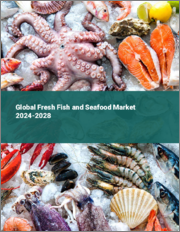
|
시장보고서
상품코드
1673782
신선 생선 시장 규모, 점유율, 성장 분석, 제품별, 형태별, 유통 채널별, 지역별 - 산업 예측(2025-2032년)Fresh Fish Market Size, Share, and Growth Analysis, By Product (Pelagic Fish, Demersal Fish), By Form (Fresh, Frozen), By Distribution Channel, By Region - Industry Forecast 2025-2032 |
||||||
신선 생선 세계 시장 규모는 2023년 2,353억 1,000만 달러로 평가되었습니다. 또한, 2024년 2,435억 5,000만 달러에서 2032년에는 3,207억 달러로 성장하고, 예측 기간(2025-2032년) 동안 3.5%의 연평균 복합 성장률(CAGR)을 보일 것으로 예측됩니다.
유엔식량농업기구(FAO)에 따르면, 전 세계 식용 생선 소비량은 인구 증가율을 상회하고 있으며, 만성질환 위험 감소 등 생선의 건강상의 이점에 대한 인식이 높아짐에 따라 세계 생선 시장이 크게 성장할 것으로 예상됩니다. 그 원동력이 되고 있습니다. 콜드체인 물류 및 유통의 혁신은 생선 생산량 증가와 함께 시장 확대를 더욱 촉진하고 있습니다. 고칼로리 식품보다 단백질이 풍부한 식단을 선호하는 경향이 높아짐에 따라 생선은 필수 오메가3 지방산이 풍부한 저지방 단백질 공급원으로 자리매김하고 있습니다. 이러한 증가 추세는 도시화, 소득 증가, 고급스럽고 다양한 식품 옵션에 대한 선호도 증가에 힘입어 인도와 인도네시아와 같은 급성장 시장에서 특히 두드러지게 나타나고 있습니다.
목차
서론
- 조사 목적
- 조사 범위
- 정의
조사 방법
- 정보 조달
- 2차와 1차 데이터 방법
- 시장 규모 예측
- 시장 전제조건과 제한
주요 요약
- 세계 시장 전망
- 공급과 수요 동향 분석
- 부문별 기회 분석
시장 역학과 전망
- 시장 개요
- 시장 규모
- 시장 역학
- 성장 촉진요인과 기회
- 성장 억제요인과 과제
- Porter의 Five Forces 분석
주요 시장 인사이트
- 중요 성공 요인
- 경쟁 정도
- 주요 투자 기회
- 시장 생태계
- 시장의 매력 지수(2024년)
- PESTEL 분석
- 거시경제 지표
- 밸류체인 분석
- 가격 분석
- 규제 분석
신선 생선 시장 규모 : 제품별
- 시장 개요
- 원양 어류
- 인근해 어류
신선 생선 시장 규모 : 형태별
- 시장 개요
- 신선
- 냉동
신선 생선 시장 규모 : 유통 채널별
- 시장 개요
- 오프라인
- 온라인
신선 생선 시장 규모
- 북미
- 미국
- 캐나다
- 유럽
- 독일
- 스페인
- 프랑스
- 영국
- 이탈리아
- 기타 유럽
- 아시아태평양
- 중국
- 인도
- 일본
- 한국
- 기타 아시아태평양
- 라틴아메리카
- 브라질
- 기타 라틴아메리카
- 중동 및 아프리카
- GCC 국가
- 남아프리카공화국
- 기타 중동 및 아프리카
경쟁 정보
- 주요 5개사 비교
- 주요 기업의 시장 포지셔닝(2024년)
- 주요 시장 기업이 채택한 전략
- 최근 시장 동향
- 기업의 시장 점유율 분석(2024년)
- 주요 기업 개요
- 기업 상세
- 제품 포트폴리오 분석
- 기업 부문별 점유율 분석
- 매출 전년대비 비교(2022-2024년)
주요 기업 개요
- Maruha Nichiro Corporation(Japan)
- Nippon Suisan Kaisha(Nissui)(Japan)
- Thai Union Group(Thailand)
- Mowi ASA(Norway)
- SalMar ASA(Norway)
- Leroy Seafood Group(Norway)
- Grieg Seafood ASA(Norway)
- Bakkafrost(Faroe Islands)
- Australis Seafoods S.A.(Chile)
- Camanchaca S.A.(Chile)
- High Liner Foods(Canada)
- Tassal Group Limited(Australia)
- Sanford Limited(New Zealand)
- Clearwater Seafoods Incorporated(Canada)
- Pacific Seafood Group(United States)
- Cooke Aquaculture(Canada)
- Nissui Corporation(Japan)
- Pesquera Exalmar S.A.A.(Peru)
- Empresas AquaChile S.A.(Chile)
- Stolt-Nielsen Limited(United Kingdom)
결론과 제안
LSH 25.04.23Global Fresh Fish Market size was valued at USD 235.31 billion in 2023 and is poised to grow from USD 243.55 billion in 2024 to USD 320.7 billion by 2032, growing at a CAGR of 3.5% during the forecast period (2025-2032).
The global market for fish is poised for substantial growth, driven by surging demand across both developed and developing nations. According to the Food and Agriculture Organization (FAO), global consumption of food fish is outpacing population growth, driven by heightened awareness of the health benefits of fresh fish, including its role in reducing chronic disease risks. Innovations in cold chain logistics and distribution, coupled with increased fish production, are further catalyzing market expansion. The rise in preference for protein-rich diets over high-calorie foods positions fish as a desirable low-fat protein source, rich in essential omega-3 fatty acids. This upward trend is especially pronounced in burgeoning markets like India and Indonesia, fueled by urbanization, rising incomes, and a growing appetite for premium, diverse food options.
Top-down and bottom-up approaches were used to estimate and validate the size of the Global Fresh Fish market and to estimate the size of various other dependent submarkets. The research methodology used to estimate the market size includes the following details: The key players in the market were identified through secondary research, and their market shares in the respective regions were determined through primary and secondary research. This entire procedure includes the study of the annual and financial reports of the top market players and extensive interviews for key insights from industry leaders such as CEOs, VPs, directors, and marketing executives. All percentage shares split, and breakdowns were determined using secondary sources and verified through Primary sources. All possible parameters that affect the markets covered in this research study have been accounted for, viewed in extensive detail, verified through primary research, and analyzed to get the final quantitative and qualitative data.
Global Fresh Fish Market Segments Analysis
Global Fresh Fish Market is segmented by Product, Form, Distribution Channel and region. Based on Product, the market is segmented into Pelagic Fish and Demersal Fish. Based on Form, the market is segmented into Fresh and Frozen. Based on Distribution Channel, the market is segmented into Offline and Online. Based on region, the market is segmented into North America, Europe, Asia Pacific, Latin America and Middle East & Africa.
Driver of the Global Fresh Fish Market
The Global Fresh Fish market is significantly influenced by the rising demand for protein-rich diets as consumers increasingly opt for alternatives to high-calorie foods. Fresh fish provides a low-fat protein source while offering essential vitamins, including omega-3 fatty acids, vital for muscle development and overall well-being. This growing health consciousness among consumers is anticipated to persist throughout the forecast period, driving interest in natural, sustainable, and nutritious food options. As more individuals prioritize their health and seek out beneficial dietary choices, the market for fresh fish continues to thrive and evolve, catering to these preferences.
Restraints in the Global Fresh Fish Market
A significant limitation in the global fresh fish market is the environmental consequences associated with commercial fishing and aquaculture. Practices such as overfishing, habitat destruction, and pollution threaten to deplete fish populations and damage marine ecosystems. Moreover, the use of antibiotics and chemicals in fish farming raises consumer apprehensions regarding the safety and sustainability of these products. In response to these challenges, there is an increasing focus on adopting sustainable and responsible fishing methodologies, alongside the advancement of innovative technologies aimed at improving fish production. Addressing these issues is vital for maintaining consumer trust and ensuring the market's long-term viability.
Market Trends of the Global Fresh Fish Market
The global fresh fish market is experiencing a notable shift towards sustainability and traceability, driven by rising consumer awareness regarding environmental impacts and ethical sourcing practices. As more individuals prioritize eco-friendly choices, demand for responsibly harvested fish is surging, prompting businesses to implement sustainable fishing and aquaculture methods. This trend fuels investments in technology that enhances supply chain transparency, enabling brands to provide verifiable information about their sourcing. Additionally, stringent labeling and certification processes are being adopted to foster consumer trust and confidence, ultimately shaping a market landscape that values not only quality but also ethical consumption patterns.
Table of Contents
Introduction
- Objectives of the Study
- Scope of the Report
- Definitions
Research Methodology
- Information Procurement
- Secondary & Primary Data Methods
- Market Size Estimation
- Market Assumptions & Limitations
Executive Summary
- Global Market Outlook
- Supply & Demand Trend Analysis
- Segmental Opportunity Analysis
Market Dynamics & Outlook
- Market Overview
- Market Size
- Market Dynamics
- Drivers & Opportunities
- Restraints & Challenges
- Porters Analysis
- Competitive rivalry
- Threat of substitute
- Bargaining power of buyers
- Threat of new entrants
- Bargaining power of suppliers
Key Market Insights
- Key Success Factors
- Degree of Competition
- Top Investment Pockets
- Market Ecosystem
- Market Attractiveness Index, 2024
- PESTEL Analysis
- Macro-Economic Indicators
- Value Chain Analysis
- Pricing Analysis
- Regulatory Analysis
Global Fresh Fish Market Size by Product & CAGR (2025-2032)
- Market Overview
- Pelagic Fish
- Demersal Fish
Global Fresh Fish Market Size by Form & CAGR (2025-2032)
- Market Overview
- Fresh
- Frozen
Global Fresh Fish Market Size by Distribution Channel & CAGR (2025-2032)
- Market Overview
- Offline
- Online
Global Fresh Fish Market Size & CAGR (2025-2032)
- North America (Product, Form, Distribution Channel)
- US
- Canada
- Europe (Product, Form, Distribution Channel)
- Germany
- Spain
- France
- UK
- Italy
- Rest of Europe
- Asia Pacific (Product, Form, Distribution Channel)
- China
- India
- Japan
- South Korea
- Rest of Asia-Pacific
- Latin America (Product, Form, Distribution Channel)
- Brazil
- Rest of Latin America
- Middle East & Africa (Product, Form, Distribution Channel)
- GCC Countries
- South Africa
- Rest of Middle East & Africa
Competitive Intelligence
- Top 5 Player Comparison
- Market Positioning of Key Players, 2024
- Strategies Adopted by Key Market Players
- Recent Developments in the Market
- Company Market Share Analysis, 2024
- Company Profiles of All Key Players
- Company Details
- Product Portfolio Analysis
- Company's Segmental Share Analysis
- Revenue Y-O-Y Comparison (2022-2024)
Key Company Profiles
- Maruha Nichiro Corporation (Japan)
- Company Overview
- Business Segment Overview
- Financial Updates
- Key Developments
- Nippon Suisan Kaisha (Nissui) (Japan)
- Company Overview
- Business Segment Overview
- Financial Updates
- Key Developments
- Thai Union Group (Thailand)
- Company Overview
- Business Segment Overview
- Financial Updates
- Key Developments
- Mowi ASA (Norway)
- Company Overview
- Business Segment Overview
- Financial Updates
- Key Developments
- SalMar ASA (Norway)
- Company Overview
- Business Segment Overview
- Financial Updates
- Key Developments
- Leroy Seafood Group (Norway)
- Company Overview
- Business Segment Overview
- Financial Updates
- Key Developments
- Grieg Seafood ASA (Norway)
- Company Overview
- Business Segment Overview
- Financial Updates
- Key Developments
- Bakkafrost (Faroe Islands)
- Company Overview
- Business Segment Overview
- Financial Updates
- Key Developments
- Australis Seafoods S.A. (Chile)
- Company Overview
- Business Segment Overview
- Financial Updates
- Key Developments
- Camanchaca S.A. (Chile)
- Company Overview
- Business Segment Overview
- Financial Updates
- Key Developments
- High Liner Foods (Canada)
- Company Overview
- Business Segment Overview
- Financial Updates
- Key Developments
- Tassal Group Limited (Australia)
- Company Overview
- Business Segment Overview
- Financial Updates
- Key Developments
- Sanford Limited (New Zealand)
- Company Overview
- Business Segment Overview
- Financial Updates
- Key Developments
- Clearwater Seafoods Incorporated (Canada)
- Company Overview
- Business Segment Overview
- Financial Updates
- Key Developments
- Pacific Seafood Group (United States)
- Company Overview
- Business Segment Overview
- Financial Updates
- Key Developments
- Cooke Aquaculture (Canada)
- Company Overview
- Business Segment Overview
- Financial Updates
- Key Developments
- Nissui Corporation (Japan)
- Company Overview
- Business Segment Overview
- Financial Updates
- Key Developments
- Pesquera Exalmar S.A.A. (Peru)
- Company Overview
- Business Segment Overview
- Financial Updates
- Key Developments
- Empresas AquaChile S.A. (Chile)
- Company Overview
- Business Segment Overview
- Financial Updates
- Key Developments
- Stolt-Nielsen Limited (United Kingdom)
- Company Overview
- Business Segment Overview
- Financial Updates
- Key Developments











